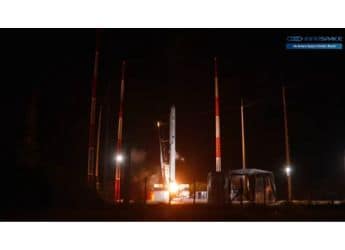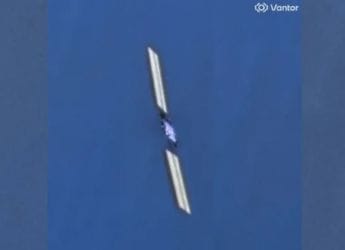- Home
- Science
- Science News
- China's Tiangong Space Lab Mostly Burns Up on Re Entry in South Pacific
China's Tiangong Space Lab Mostly Burns Up on Re-Entry in South Pacific
A model of the Tiangong-1 space lab module (L) and the Shenzhou-9 manned spacecraft (R)
China's defunct Tiangong 1 space station mostly burned up on re-entry Monday into the atmosphere over the central South Pacific, Chinese space authorities said.
The experimental space laboratory re-entered around 8:15am, the China Manned Space Engineering Office said.
Scientists monitoring the craft's disintegrating orbit had forecast the craft would mostly burn up and would pose only the slightest of risks to people. Analysis from the Beijing Aerospace Control Center showed it had mostly burned up.
Brad Tucker, an astrophysicist at Australian National University, said Tiangong 1's re-entry was "mostly successful" and that it would have been better if the space station had not been spinning toward Earth.
"It could have been better obviously, if it wasn't tumbling, but it landed in the Southern Pacific Ocean and that's kind of where you hope it would land," Tucker said.
"It's been tumbling and spinning for a while, which means that when it really starts to come down it's less predictable about what happens to it," Tucker said. He likened it to an airplane landing, saying it's more difficult to predict where a plane that is "shaking around and moving" will land than one that is smoothly descending.
Launched in 2011, Tiangong 1 was China's first space station, serving as an experimental platform for bigger projects, such as the Tiangong 2 launched in September 2016 and a future permanent Chinese space station.
Two crews of Chinese astronauts lived on the station while testing docking procedures and other operations. Its last crew departed in 2013 and contact with it was cut in 2016.
Since then, it has orbited gradually closer and closer to Earth on its own while being monitored.
Earlier forecasts had said only about 10 percent of the bus-sized, 8.5-ton spacecraft would likely survive re-entry, mainly its heavier components such as its engines.
"The biggest takeaway from this is that as we put more things into space, all countries, we have to be aware that we do have to plan for these sorts of issues that are happening," Tucker said.
Debris from satellites, space launches and the International Space Station enters the atmosphere every few months, but only one person is known to have been hit by any of it: American woman Lottie Williams, who was struck but not injured by a falling piece of a US Delta II rocket while exercising in an Oklahoma park in 1997.
Most famously, America's 77-ton Skylab crashed through the atmosphere in 1979, spreading pieces of wreckage near the southwestern Australia city of Perth, which fined the US $400 for littering.
Get your daily dose of tech news, reviews, and insights, in under 80 characters on Gadgets 360 Turbo. Connect with fellow tech lovers on our Forum. Follow us on X, Facebook, WhatsApp, Threads and Google News for instant updates. Catch all the action on our YouTube channel.
Related Stories
- Samsung Galaxy Unpacked 2025
- ChatGPT
- Redmi Note 14 Pro+
- iPhone 16
- Apple Vision Pro
- Oneplus 12
- OnePlus Nord CE 3 Lite 5G
- iPhone 13
- Xiaomi 14 Pro
- Oppo Find N3
- Tecno Spark Go (2023)
- Realme V30
- Best Phones Under 25000
- Samsung Galaxy S24 Series
- Cryptocurrency
- iQoo 12
- Samsung Galaxy S24 Ultra
- Giottus
- Samsung Galaxy Z Flip 5
- Apple 'Scary Fast'
- Housefull 5
- GoPro Hero 12 Black Review
- Invincible Season 2
- JioGlass
- HD Ready TV
- Laptop Under 50000
- Smartwatch Under 10000
- Latest Mobile Phones
- Compare Phones
- Huawei Nova 15
- Huawei Nova 15 Pro
- Huawei Nova 15 Ultra
- OnePlus 15R
- Realme Narzo 90x 5G
- Realme Narzo 90 5G
- Vivo S50 Pro Mini
- Vivo S50
- Asus ProArt P16
- MacBook Pro 14-inch (M5, 2025)
- Huawei MatePad 11.5 (2026)
- OnePlus Pad Go 2 (5G)
- Huawei Watch 10th Anniversary Edition
- OnePlus Watch Lite
- Acerpure Nitro Z Series 100-inch QLED TV
- Samsung 43 Inch LED Ultra HD (4K) Smart TV (UA43UE81AFULXL)
- Asus ROG Ally
- Nintendo Switch Lite
- Haier 1.6 Ton 5 Star Inverter Split AC (HSU19G-MZAID5BN-INV)
- Haier 1.6 Ton 5 Star Inverter Split AC (HSU19G-MZAIM5BN-INV)

















